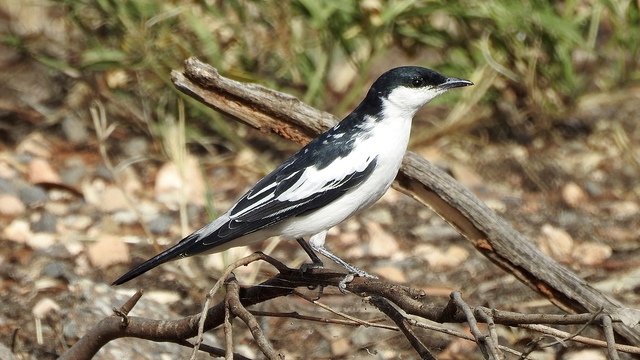
Look up in the Air! with Paul Taylor
I caught up with Paul at The Rocks Reserve a couple of weeks ago when I was looking for signs of rain. He has furnished us with another bird this month – the cuckoo-shrike.
CUCKOO-SHRIKES
Some birds in Australia have hyphenated names which are the combination of names of different birds.
Examples of these are magpie-lark, shrike-thrush, quail-thrush and cuckoo-shrike.
This came about because they have characteristics (in appearance) of both kinds of birds. Most of them, however, are not related to either of the birds in their name.
Cuckoo-shrikes are so-named because they have the slender shape of a cuckoo (and fly like them as well), and a strong bill (beak) like a shrike.
There are a lot of different kinds of cuckoo-shrikes, and they are found in Asia and Africa as well as Australia.
The black-faced cuckoo-shrike occurs all over Australia and is commonly seen on the Adelaide Plains and in the Mid North. It is just over 30 centimetres long and is readily identified with light grey plumage and a black face and throat. (Although young birds have just a black strip through the eye).
The call is a rather distinctive churring trill.
Black-faced cuckoo-shrikes are quite conspicuous and are often along roadsides. Their flight is undulating and when landing, they have the habit of shuffling and refolding their wings.
Cuckoo-shrikes have a varied diet that includes caterpillars (as do cuckoos). Hairy caterpillars may not seem that appealing, but they are one of their favourite foods.
Autumn is the time when many birds are on the move. In southern Australia a lot fly north for the winter, including black-faced cuckoo-shrikes.
Not all leave our local area, but flocks can be seen departing for northern Australia. A few even reach New Guinea. They return in the spring.
Another species of cuckoo-shrike (with a different name) that usually arrives here in spring is the white-winged triller. It is a small and striking black and white cuckoo-shrike.
Black-faced cuckoo-shrike is a long name, and triller is not as cumbersome as cuckoo-shrike.
However, the original early name for the white-winged triller was an extra lengthy, white-shouldered caterpillar-eater!
Where is the elusive break to the season?
The number of predictions left standing is tapering off rapidly and it is looking more and more like a June break this year.
If none of these guesses below hit the mark, the prize is awarded to nearest-the-pin.
Melissa Davis, Salter Springs – May 22
Natalie Lane, Owen – May 22
Craig Davis, Salter Springs – May 25
Richard Fabry, Long Plains – May 25
Mark Parish, Auburn – May 25
Dylan Wood, Owen – May 27
Jake Harkness, Owen – May 30 (37mm)
Paul Lange, Adelaide – May 31
Jon Harkness, Owen – June 3
Bazz Harkness, Owen – June 10
Cliff Fabry, Owen – June 28
‘The springs are up’ and heading downstream according to resident Wakefield River expert Peter McPharlin.
When the waterholes upstream of The Rocks Reserve fill from underground springs it typically means we will receive opening rains around a fortnight later, so it is looking like end May/early June for our season break.
There are a few other nature signs showing up as well, including rain moths, swarming termites – and, of course, the fact that we all know it always rains after a dry spell.
Also, according to our other rainfall guru Glen Bubner, the trees are leaning to the east, flies are flying anti-clockwise, mosquitoes are mating, kangaroos are grazing on low areas, and magpies are only singing after 9.30pm – all these are sure signs of a big rain event on the way.
Glen has also predicted two big blows, which the media will call a ‘State Disaster, like nothing seen in 40 years!’
Federal Government to phase out live sheep exports
Livestock and grain farmers across the nation are baffled by the recent announcement to phase out live sheep exports.
Livestock SA and Grain Producers SA are united in their stance against this alarmingly ill-conceived policy which is set to have a significant impact on livestock producers across the nation.
GPSA chairperson John Gladigau said the decision was set to have a negative flow-on effect for agriculture broadly including the SA grain industry.
“We are urging the Government to cease being swayed by selective activist agendas and instead engage constructively with stakeholders who have a vested interest in the prosperity of Australian agriculture.
“Many South Australian grain producers also run livestock and the concern is that the phase out of live sheep exports will have repercussions for every single farmer as Western Australian sheep producers look for alternative markets.
“The decision to shut an essential sheep market, renowned for its world-leading animal welfare standards, disregards the crucial role live exports play in providing flexibility to the industry during periods of drought and adjustment.”







